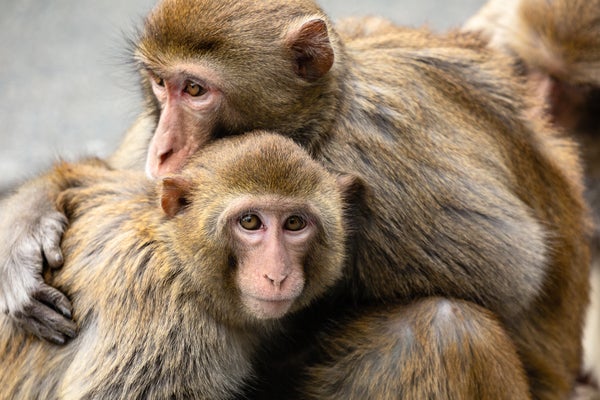A Study in Primates Reveals How the Brain Encodes Complex Social Interactions
The research tracks, at the level of individual neurons, what happens when a monkey hangs out with other monkeys. It even found a possible neural code for empathy
By Lydia Denworth

Credit:
Zane Michael Cooper/Getty Images
Reciprocity—I scratch your back; you scratch mine—has long been thought to be one of the hallmarks of friendship and other close relationships. In the world of nonhuman primates, the back-scratching is literal. Monkeys take turns grooming one another as a form of hygiene and social bonding.
According to a striking new study, that turn taking is precisely calibrated over time. It’s a calculated reciprocity that tracks social investment using complex brain circuitry at the level of individual neurons across remarkably different parts of the brain. The paper, published in Nature on March 13, shows, for the first time, how social behavior is encoded in the brain while monkeys are engaged in everyday monkey business rather than narrow laboratory tasks. And it reveals similar brain processing that underpins other forms of social behavior, such as giving support. “Our findings reveal a highly distributed neurophysiological ledger of social dynamics, a potential computational foundation supporting communal life in primate societies, including our own,” the authors write.
Until recently, “all of the neuroscience in primates, including humans, has been done in highly restricted environments,” says co-lead author Camille Testard, who is now a postdoctoral fellow at Harvard University and will become a junior fellow there in July. By contrast, the new study, which was part of Testard’s Ph.D. thesis as a student of neuroscientist Michael Platt at the University of Pennsylvania, involved observing male-female pairs of rhesus macaques for two and a half hour stretches in their home enclosure in a laboratory in three different situations: the male alone, the male with his long-standing female partner and the pair together while a neighbor was visible. It was both a more natural setup and a more ethical one, Testard says, because it was less invasive than traditional studies.
On supporting science journalism
If you’re enjoying this article, consider supporting our award-winning journalism by subscribing. By purchasing a subscription you are helping to ensure the future of impactful stories about the discoveries and ideas shaping our world today.
Using very small wireless data loggers and a Food and Drug Administration–approved implant that is used in humans for brain-machine interface applications, the team collected information on the activity of hundreds of single neurons in the brains of the males. These neurons resided in two brain areas that represent relatively opposite ends of the information processing pathway: the inferotemporal cortex, which handles intermediate steps in visual processing, and a part of the prefrontal cortex that combines contextual information to support higher-order thinking such as decision-making.
The researchers expected brain responses in the visual area to be very different from those in the prefrontal cortex, but the two areas showed remarkably similar activity. “It was very clearly segregated and structured by both the current behavior of the animal and their social context,” Testard says. “These neurons track what I’m doing right now, who I’m doing it with, who’s around when I’m doing this, how much [I have] been interacting with my partner, how much [they have] given me versus how much I’ve given them.”
“These are, quite frankly, extraordinary discoveries,” says psychologist Robert Seyfarth, an emeritus professor at University of Pennsylvania, who spent decades studying social behavior in primates and was consulted for the new study but was not directly involved in the research. “The neural basis of such subtly complex social behavior has never been documented before.”
Testard and her colleagues investigated specific forms of interaction that make up typical macaque behavior, such as social support and grooming. For instance, after more than a month of experimenting and collecting data on the roughly 20,000 seconds of time that the pairs of monkeys spent grooming, there was ultimately only a 50-second difference in the amount of grooming one animal received over the other.
When the researchers imitated aggressive macaque behavior by looking the monkeys directly in the eye, the male animals got agitated and a little aggressive, as expected. But that response was tempered when the female partner was present, demonstrating the buffering effects of having a social ally. When the threat was delivered to the female instead of the male, the male behaved as if it had been delivered to him, a response that relates to our capacity for empathy. In addition, the monkeys’ brain clearly registered the presence of neighboring monkeys, even when a given monkey wasn’t interacting with them. Testard likened the response to our oh-so-human tendency to notice when someone we like has entered a room, even if we’re talking to someone else.
Matthew Rushworth, a cognitive neuroscientist at the University of Oxford, who was not involved in the research, called the study “impressive” both for its technological advances and its findings. “It is as if the neurons are keeping track of a register of social credit and debit,” he says.
It is still unclear if the neurons uncovered in this study are the source of social behaviors and what their malfunction might mean, but the findings could help explain how empathy breaks down in conditions such as psychopathology, says Sébastien Tremblay, a neuroscientist now of Laval University in Quebec and co-lead author of the study. “There are a million ways this ledger can be corrupted and how this can lead to conflict between two individuals,” Tremblay says. “We will not be able to fix issues related to social dysfunctions if we don’t understand how the brain in the first place generates social cognition, how the neurons in the brain really allow these complex behaviors to happen.”
>>> Read full article>>>
Copyright for syndicated content belongs to the linked Source : Scientific American – https://www.scientificamerican.com/article/a-study-in-primates-reveals-how-the-brain-encodes-complex-social/































